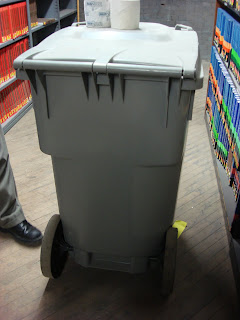Even here, however, there are several possibilities. Among the libraries with which SCS has worked, we have heard the following possibilities discussed. Withdrawn books can be:
- transferred to storage
- donated to another library
- sold
- shredded
- recycled
However, the cost for other steps can vary considerably, both for record maintenance and for materials handling. In general, costs increase to the degree that the 10,000 unit batch must be broken down into smaller portions to handle. To put it bluntly, it is much less labor-intensive to throw books in a dumpster than it is to pack them 20-25 to a box, or to fill wheeled bins for shredding. It is much less labor-intensive to dispose of an entire batch at once than to sell the portion that may be saleable over time. Let's look at each option individually:
- Transfer to Storage: For record maintenance, transfers lend themselves nicely to batch work, in which changes to location, circulation status, and a few other data elements can be handled for many items in a single step. However, for shared storage, it is sometimes necessary to replace an individual library barcode with a consortial version, and to apply new ownership stamps. This necessitates handling every item individually.
- Donating books to another library or charitable organization such as Better World Books or Folio Fund is often seen as preferable to outright discard. The books will have a second chance to circulate elsewhere. Withdrawals can be managed in batch, as can removal of holdings from OCLC. But the books have to be boxed for shipment, which requires packing approximately 500 boxes plus the expense of shipping them to their destination. Not all books are eligible for donation, which in some cases requires searching to determine if titles qualify.
- Selling withdrawn titles also has a certain appeal, and if we think too hard about how much money we actually spent to acquire these 10,000 books in the first place, it's tempting to try and recoup some of it. In our experience, this is dangerous ground. In her 2005 study "Library book sales: A cost-benefit analysis", Audrey Fenner determined that all of the prevailing approaches cost more in staff time than the revenue they generated. There are some new tools on the market that could significantly improve prospects here, such as Alibris/Monsoon Commerce Solutions, which help assess the value of batches of titles and offer options to support selling. (These will be addressed in another post later this spring.) But absent new tools, selling should be approached with great caution.
- Shredding is in most cases unnecessary, but some libraries elect to go in this direction--at least for smaller batches--to avoid the visibility of a dumpster full of bound books. In the examples we have seen, titles to be shredded are put into smaller container that hold 200-250 volumes. While this is less labor-intensive than boxing them up, it constrains batches somewhat and of course the bins have to be transported to the shredder. Record maintenance options are essentially the same as for transfer, sale, or donation.

- Recycling, especially at scale, minimizes materials handling. Cartloads of books are simply emptied into a large container once the record maintenance has been completed. The transaction costs are low, but such a vessel certainly increases the chance of complaints from faculty, library staff, and visits from the student newspaper. Without proper advance communication, these uninformed responses from the community can end up absorbing more time than has been saved.
Links to related posts:
- Cost of Deselection (1)
- Cost of Deselection (2): Fixed Costs
- Cost of Deselection (3): Wage Rates
- Cost of Deselection (4): Data Comparisons
- Cost of Deselection (5): Title Review from Lists
- Cost of Deselection (6): In-Stack Review
- Cost of Deselection (7): Staged Review
- Cost of Deselection (9): Data Comparisons Revisited
- Cost of Deselection (10): Summing Up
- Withdrawals and Deposits
- Withdrawals and Deposits (2)





